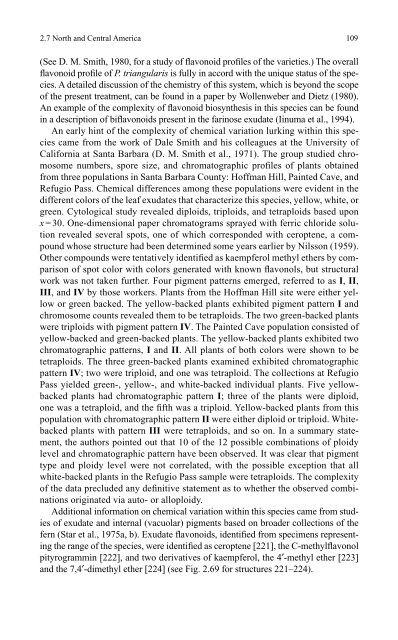The Geography of Phytochemical Races
The Geography of Phytochemical Races
The Geography of Phytochemical Races
Create successful ePaper yourself
Turn your PDF publications into a flip-book with our unique Google optimized e-Paper software.
2.7 North and Central America 109<br />
(See D. M. Smith, 1980, for a study <strong>of</strong> fl avonoid pr<strong>of</strong>i les <strong>of</strong> the varieties.) <strong>The</strong> overall<br />
fl avonoid pr<strong>of</strong>i le <strong>of</strong> P. triangularis is fully in accord with the unique status <strong>of</strong> the species.<br />
A detailed discussion <strong>of</strong> the chemistry <strong>of</strong> this system, which is beyond the scope<br />
<strong>of</strong> the present treatment, can be found in a paper by Wollenweber and Dietz (1980).<br />
An example <strong>of</strong> the complexity <strong>of</strong> fl avonoid biosynthesis in this species can be found<br />
in a description <strong>of</strong> bifl avonoids present in the farinose exudate (Iinuma et al., 1994).<br />
An early hint <strong>of</strong> the complexity <strong>of</strong> chemical variation lurking within this species<br />
came from the work <strong>of</strong> Dale Smith and his colleagues at the University <strong>of</strong><br />
California at Santa Barbara (D. M. Smith et al., 1971). <strong>The</strong> group studied chromosome<br />
numbers, spore size, and chromatographic pr<strong>of</strong>i les <strong>of</strong> plants obtained<br />
from three populations in Santa Barbara County: H<strong>of</strong>fman Hill, Painted Cave, and<br />
Refugio Pass. Chemical differences among these populations were evident in the<br />
different colors <strong>of</strong> the leaf exudates that characterize this species, yellow, white, or<br />
green. Cytological study revealed diploids, triploids, and tetraploids based upon<br />
x = 30. One-dimensional paper chromatograms sprayed with ferric chloride solution<br />
revealed several spots, one <strong>of</strong> which corresponded with ceroptene, a compound<br />
whose structure had been determined some years earlier by Nilsson (1959).<br />
Other compounds were tentatively identifi ed as kaempferol methyl ethers by comparison<br />
<strong>of</strong> spot color with colors generated with known fl avonols, but structural<br />
work was not taken further. Four pigment patterns emerged, referred to as I, II,<br />
III, and IV by those workers. Plants from the H<strong>of</strong>fman Hill site were either yellow<br />
or green backed. <strong>The</strong> yellow-backed plants exhibited pigment pattern I and<br />
chromosome counts revealed them to be tetraploids. <strong>The</strong> two green-backed plants<br />
were triploids with pigment pattern IV. <strong>The</strong> Painted Cave population consisted <strong>of</strong><br />
yellow-backed and green-backed plants. <strong>The</strong> yellow-backed plants exhibited two<br />
chromatographic patterns, I and II. All plants <strong>of</strong> both colors were shown to be<br />
tetraploids. <strong>The</strong> three green-backed plants examined exhibited chromatographic<br />
pattern IV; two were triploid, and one was tetraploid. <strong>The</strong> collections at Refugio<br />
Pass yielded green-, yellow-, and white-backed individual plants. Five yellowbacked<br />
plants had chromatographic pattern I; three <strong>of</strong> the plants were diploid,<br />
one was a tetraploid, and the fi fth was a triploid. Yellow-backed plants from this<br />
population with chromatographic pattern II were either diploid or triploid. Whitebacked<br />
plants with pattern III were tetraploids, and so on. In a summary statement,<br />
the authors pointed out that 10 <strong>of</strong> the 12 possible combinations <strong>of</strong> ploidy<br />
level and chromatographic pattern have been observed. It was clear that pigment<br />
type and ploidy level were not correlated, with the possible exception that all<br />
white-backed plants in the Refugio Pass sample were tetraploids. <strong>The</strong> complexity<br />
<strong>of</strong> the data precluded any defi nitive statement as to whether the observed combinations<br />
originated via auto- or alloploidy.<br />
Additional information on chemical variation within this species came from studies<br />
<strong>of</strong> exudate and internal (vacuolar) pigments based on broader collections <strong>of</strong> the<br />
fern (Star et al., 1975a, b). Exudate fl avonoids, identifi ed from specimens representing<br />
the range <strong>of</strong> the species, were identifi ed as ceroptene [221], the C-methylfl avonol<br />
pityrogrammin [222], and two derivatives <strong>of</strong> kaempferol, the 4′-methyl ether [223]<br />
and the 7,4′-dimethyl ether [224] (see Fig. 2.69 for structures 221–224).
















